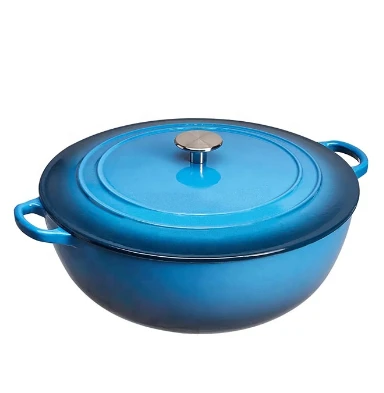
can you re enamel a cast iron pot
Can You Re-enamel a Cast Iron Pot?
Cast iron pots are cherished for their excellent heat retention and even cooking capabilities. They are kitchen staples that can last a lifetime if properly cared for. However, over time, even the most beloved cast iron cookware can experience wear and tear, particularly in the enamel coating. This prompts the question can you re-enamel a cast iron pot, and if so, how?
Understanding Enamel Coating
Firstly, it’s important to understand what enamel is. Enamel is a vitreous coating that is baked onto the surface of cast iron to create a non-reactive, smooth finish. This coating not only gives the cookware an aesthetic appeal but also makes it easier to clean, prevents rust, and allows for cooking with acidic foods without fear of damaging the pot.
Signs Your Enamel Needs Attention
If you notice chips, cracks, or discoloration in your cast iron pot’s enamel, it may need repair or replacement. While some minor scratches can be tolerated, larger damage can expose the raw cast iron, leaving it vulnerable to rust and ruining the pot’s non-stick qualities. Moreover, long-term use of a damaged pot can lead to food sticking, burning, and uneven cooking.
Can You Re-enamel?
The answer to whether you can re-enamel a cast iron pot is nuanced. In theory, it is possible to apply a new layer of enamel to a cast iron pot, but it is not a simple DIY project and typically involves professional help. The re-enameling process requires specialized equipment and materials, as the enamel must be applied at high temperatures in a kiln to ensure proper bonding to the cast iron surface.
Professional Re-enameling Services
can you re enamel a cast iron pot

If your pot is significantly damaged, seeking out professional re-enameling services is your best bet. Many companies specialize in this process, and while it can be costly, it often results in a beautifully restored piece of cookware that can continue to serve you for many years. A professional can evaluate the extent of the damage and provide the best options, including a complete restoration or simply refacing the affected areas.
DIY Alternatives
For those looking for a more affordable solution, there are DIY options, although they may not yield the same results as professional services. High-temperature paint designed for cookware can be used to cover minor chips and scratches but is generally not recommended for significant re-enameling. These paints may not withstand the same heat as a properly vitrified enamel and might affect the flavor of your food.
If you opt for a DIY fix, ensure that you follow all safety instructions, including proper ventilation. Keep in mind that these solutions are temporary and that the long-term durability of the repair may be questionable.
Preventative Care
To avoid the need for re-enameling altogether, taking care of your cast iron cookware is essential. Avoid using metal utensils that can scratch the enamel, and be cautious with high-acid foods that can wear down the coating over time. Clean your pots gently, using non-abrasive sponges, and avoid soaking them in water for prolonged periods.
Conclusion
While you can technically re-enamel a cast iron pot, it's often best left to professionals due to the complexities involved. However, through proper care and maintenance, you can significantly prolong the lifespan of your enameled cast iron cookware. By doing so, you’ll not only preserve its beauty but also ensure that it continues to be a reliable companion in your kitchen for many years to come.
-
Season Cast Iron Perfectly with GPT-4 Turbo TipsNewsAug.01,2025
-
High Quality Cast Iron Cookware - Baixiang County Zhongda MachineryNewsAug.01,2025
-
Premium Cast Iron Pan: Durable & Perfect HeatNewsAug.01,2025
-
High Quality Kitchen Durable Black Round Cast Iron Cookware Pancake Crepe Pan-Baixiang County Zhongda Machinery Manufacturing Co., Ltd.NewsAug.01,2025
-
Cast Iron Cookware - Baixiang County Zhongda Machinery | Nonstick, Heat ResistanceNewsAug.01,2025
-
High Quality Kitchen Durable Black Round Cast Iron Cookware - Baixiang County Zhongda Machinery | Non-Stick, Heat Retention, DurableNewsJul.31,2025


